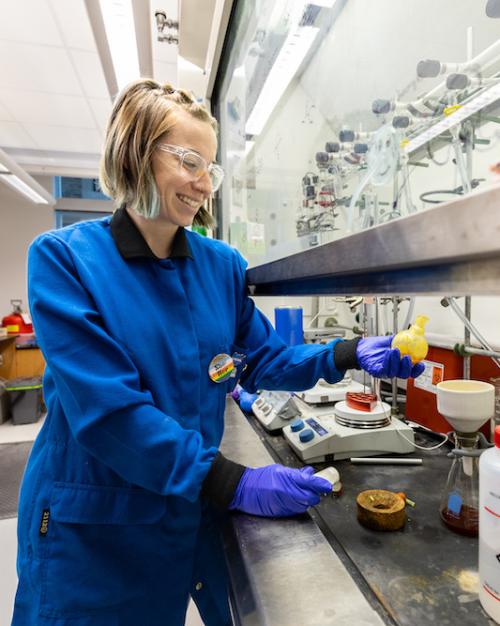Vehicle by vehicle and building by building, carbon emissions are pouring into the atmosphere, a major contributor to heating up the Earth.
“Global warming is a big issue we’re facing, and the increasing atmospheric level of carbon dioxide is one major contributor,” said Alexa Easley, Klarman Postdoctoral Fellow in chemistry and chemical biology in the College of Arts and Sciences.
Chemists, Easley among them, have the know-how to capture carbon dioxide molecules and divert the compound from the atmosphere – but how to deploy the technology on an effective scale?
With her faculty host, Brett Fors, professor of chemistry, and two other A&S faculty members, Easley is working to develop materials for low-energy carbon capture that are organic and easy to make on large scales and in realistic conditions.
“We want to be able to capture carbon dioxide at ambient conditions,” Easley said. “A lot of existing technologies require dry atmospheres to perform, but that’s not what we have in the real world. You go outside and if you want to remove atmospheric carbon dioxide, you need it to be able to perform in that atmosphere to make it industrially relevant.”
Buildings and automobiles, considered together, are one leading producer of carbon dioxide emissions, Easley said. One way to capture the gas is at the source, with devices in building ventilation and car exhaust systems. Using small amounts of energy to trigger a change in the material to react with CO2 and remove it, this addresses a large-scale problem in a small, individual way.
Such a device might contain a solution, she said. The exhaust goes straight into the solution, and the solution captures the carbon before the exhaust flows out the other side. Or a device can pump in the direct air and remove CO2 previously released into the atmosphere.
An ideal is to capture carbon in the solid state for other uses.
“Carbon dioxide is still a really useful material,” Easley said. “In chemistry, it’s used for a lot of things.”
Similar carbon-capture technologies are currently used in industry, but they are not perfect solutions. These reactor-like devices typically suffer from decomposition or diminished capabilities over time, and they are very energy intensive, working at high temperatures, Easley said. For this reason, New York State, for example, is using a reforestation strategy rather than technological carbon capture.
“We are trying to reduce the amount of energy needed to accomplish the same capture/release cycle,” Easley said. “We’re at the initial lab-scale demonstrations of its capabilities. We’re not at the industrial scale yet but that would be the hope.”
Easley’s daily work toward this goal involves a lot of synthesis in the lab of organic metal-free molecules. “We then use techniques, mainly spectroscopy, to see how our molecules are either reacting or binding to the carbon dioxide to figure out the reaction mechanisms,” she said.
Crystals are one way to tell how carbon dioxide is binding with a small molecule, Easley said, so she’s learning crystallography with some of the Cornell chemistry department’s leading experts, including Samantha N. MacMillan, director of the X-ray Diffraction Facility.
This research also includes Phillip Milner, assistant professor of chemistry and chemical biology (A&S) and Tristan Lambert, the William T. Miller professor of chemistry.
The flexibility of the Klarman fellowship allowed Easley to pivot to scalable carbon capture from her initial project, the development of plastic-based metal-free batteries, yet another solution to environmental problems. Although they seem unrelated, similar organic materials can be used for both metal-free batteries and carbon capture, she pointed out. (For example, anthraquinone has been extensively studied for both applications).
Easley started doctoral studies at Texas A&M University in biomedical engineering, aiming to work on medical device materials. However, inspired by her Ph.D. advisor Jodie Lutkenhaus, she shifted this knowledge toward polymer-based batteries. Further collaboration with Karen Wooley, an expert in making functional degradable materials, sparked Easley’s passion for chemistry-related solutions.
“That project got me started thinking about how we can make more environmentally friendly alternatives and encourage other researchers to consider the end of life for materials while they’re developing ideas, which I think might be the more important area for the results of the research,” Easley said. “A lot of design is done for the application but not end-use or trying to mitigate long-term effects.”
Easley said that the Klarman Fellowship has enabled her to pursue multiple research paths and create applications that solve problems now without creating further – or worse – problems in the future.





